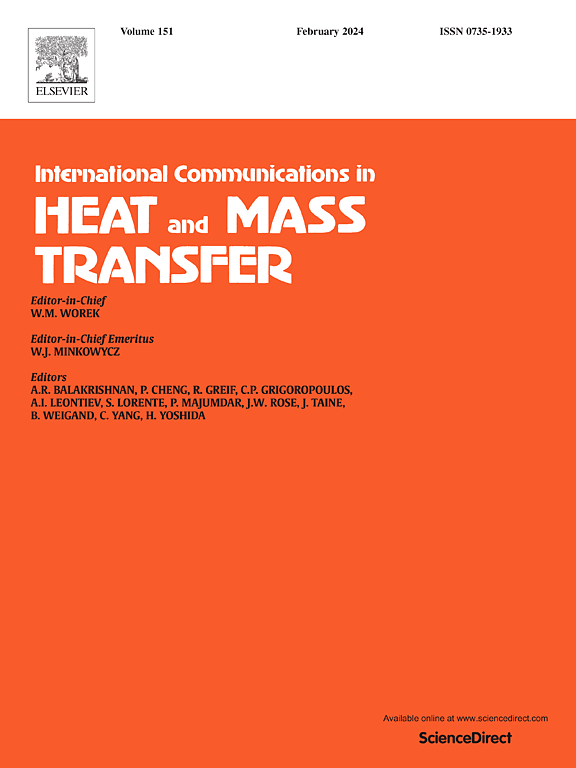Evaporation heat transfer characteristics of R290 in a chevron type plate heat exchanger under various operating conditions
IF 6.4
2区 工程技术
Q1 MECHANICS
International Communications in Heat and Mass Transfer
Pub Date : 2025-05-29
DOI:10.1016/j.icheatmasstransfer.2025.109139
引用次数: 0
Abstract
R290 has emerged as a promising alternative for R410A and R32 due to its excellent thermodynamic properties and low environmental impact. However, studies on the evaporation heat transfer characteristics of R290 in chevron-type plate heat exchangers (PHEs) remain limited. This study investigates the evaporation heat transfer performance of R290 in a chevron-type PHE under various operating conditions and compares the results with those of R410A and R32. Experiments are conducted by varying mass flux, heat flux, and saturation temperature, respectively. The average heat transfer coefficient of R290 was 4.54 kW·m−2·K−1, which was 24.3% and 12.6% higher than that of R410A and R32, respectively, due to its larger specific volume. However, the average frictional pressure drop of R290 was 112% and 64.1% higher than that of R410A and R32, respectively, owing to the greater difference in saturated specific volumes. New correlations for the Nusselt number and friction factor of R290, R410A, and R32 in chevron-type PHEs are developed by incorporating the two-phase Reynolds number, Prandtl number, and thermophysical refrigerant properties, with deviations within ±15%. Despite its higher pressure drop, R290 remains a compelling alternative to R410A and R32 due to its superior heat transfer performance and reduced environmental impact.
不同工况下R290在v形板式换热器中的蒸发换热特性
由于其优异的热力学性能和低环境影响,R290已成为R410A和R32的有希望的替代品。然而,对R290在线形板式换热器中的蒸发换热特性的研究仍然有限。研究了不同工况下,R290在chevon型板式换热器中的蒸发换热性能,并与R410A和R32进行了比较。实验分别通过改变质量通量、热通量和饱和温度进行。R290的平均换热系数为4.54 kW·m−2·K−1,比R410A和R32的平均换热系数分别高出24.3%和12.6%。但由于饱和比容差异较大,R290的平均摩擦压降分别比R410A和R32高112%和64.1%。通过引入两相雷诺数、普朗特数和制冷剂热物理性质,建立了R290、R410A和R32的努塞尔数和摩擦因数的新相关性,偏差在±15%以内。尽管R290具有更高的压降,但由于其优越的传热性能和更小的环境影响,R290仍然是R410A和R32的令人信服的替代品。
本文章由计算机程序翻译,如有差异,请以英文原文为准。
求助全文
约1分钟内获得全文
求助全文
来源期刊
CiteScore
11.00
自引率
10.00%
发文量
648
审稿时长
32 days
期刊介绍:
International Communications in Heat and Mass Transfer serves as a world forum for the rapid dissemination of new ideas, new measurement techniques, preliminary findings of ongoing investigations, discussions, and criticisms in the field of heat and mass transfer. Two types of manuscript will be considered for publication: communications (short reports of new work or discussions of work which has already been published) and summaries (abstracts of reports, theses or manuscripts which are too long for publication in full). Together with its companion publication, International Journal of Heat and Mass Transfer, with which it shares the same Board of Editors, this journal is read by research workers and engineers throughout the world.

 求助内容:
求助内容: 应助结果提醒方式:
应助结果提醒方式:


